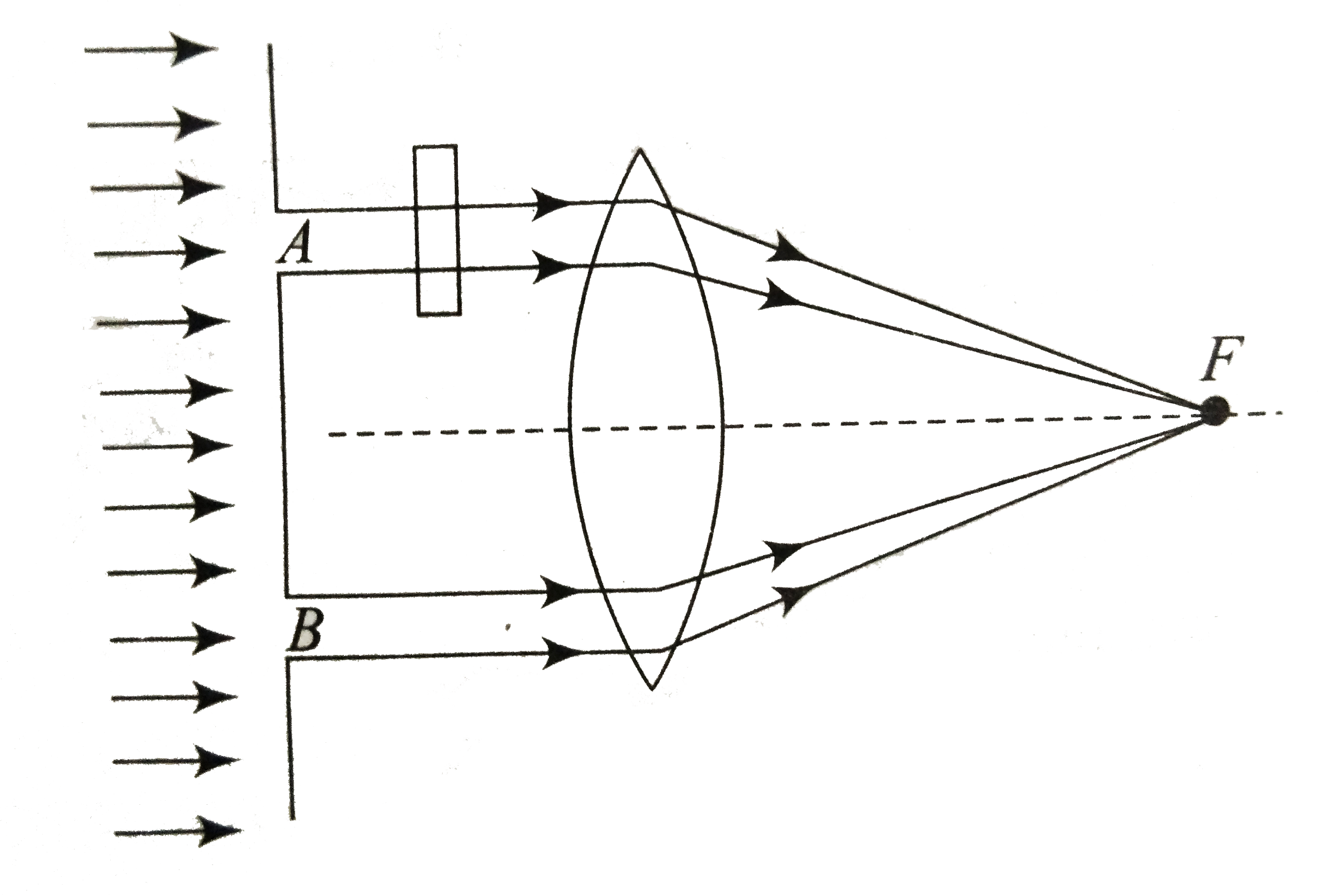Two identical monochromaticlight sources A & B intensity produce wavelength of light A glass of thickness 3mm is placed in the path of the ray as shown in figure the glass has a varible refractive index where x (in mm) is distance of plate from left to right calculate total intensity at focal points F of the lens.
_E01_100_Q01.png)
The correct Answer is:
Step by step video, text & image solution for Two identical monochromaticlight sources A & B intensity 10^(-15)W//m^(2) produce wavelength of light 4000sqrt(3)Å A glass of thickness 3mm is placed in the path of the ray as shown in figure the glass has a varible refractive index n=1+sqrt(x) where x (in mm) is distance of plate from left to right calculate total intensity at focal points F of the lens. by Physics experts to help you in doubts & scoring excellent marks in Class 12 exams.
Updated on:21/07/2023Topper's Solved these Questions
- WAVE OPTICSBOOK - PHYSICS GALAXY - ASHISH ARORACHAPTER - WAVE OPTICSEXERCISE - Advance MCQs with One or More Options Correct
27 Videos
- THERMODYNAMICS LAWS & SPECIFIC HEATS OF GASES BOOK - PHYSICS GALAXY - ASHISH ARORACHAPTER - THERMODYNAMICS LAWS & SPECIFIC HEATS OF GASES EXERCISE - Practice Exercise 3.4
11 Videos
- WAVES BOOK - PHYSICS GALAXY - ASHISH ARORACHAPTER - WAVES EXERCISE - Unsolved Numerical Problems for Preparation of NSE, INPhO & IPhO
135 Videos
Similar Questions
In a modified Young's double slit experiment a monochromatic uniform and parallel beam of light of wave length 6000Å and intensity (10π)Wm−2 is incident normally on two circular apertures A and B of radii 20009Å and refractive index 1.5 for the wavelength of 6000Å is placed in front of aperture. A. Calculate the power (in watt) received at the focal spot F of the lens. The lens is symmertrically placed with respect to the apertures. Assume that 10% of the power received by each aperture goes in the originally direction and is brought to the focal spot.

View SolutionA ray of light is icncident at anangle of 60∘ on one face of a ractangular glass slab of thickness 2√3 mm refractive index √3 , Calculate the lateral shift produced in mm.
View Solution
Knowledge Check
There is an insect a cabin eying towards thick glass plate P1, Insect sees the images of light source acrss the glass plate P1 outside tha chain. Cabin is made of thick glass plates of refractive index μ=32 and thickness 3cm. Insect is eying from the middle of the cabin as shown in figure. (glass plates are partially reflective and consider only paraxial rays)

At what distance (from eye of insect) will the eye see second image ?A11cmB13cmC16.5cmD18cmThere is an insect a cabin eying towards thick glass plate P1, Insect sees the images of light source acrss the glass plate P1 outside tha chain. Cabin is made of thick glass plates of refractive index μ=32 and thickness 3cm. Insect is eying from the middle of the cabin as shown in figure. (glass plates are partially reflective and consider only paraxial rays)

At what distance (from eye of insect) will the eye see first image?A5cmB7cmC11cmD14cmA thin glass plate of thickness t(=λ/3,λ being the wavelength of incident light ) and refractive index μ=1.5 is inserted between one of the slits and the screen in Young's double slit experiment. If the intensity at a point on the screen equidistance from the slit is i, then
Aintensity at the same point before introduction of glass plate was 31/2Bintensity at the same point before introduction of glass plate was 41/3Ccentral maximum will be in the lower half of screen after introduction of glass plateDshape of fringes will be straight line on the screen
A equilateral glass prism has a refractive index √(2) . A light ray is incident at 45^∘ on one face.Total deviation of ray after refraction from second surface is n times15^(0) where 'n' is
View SolutionIn a modified Young's double-slit experiment, a monochromatic uniform and parallel beam of light of wavelength 6000Å and intensity (10/π) W m−2 is incident normally on two circular apertures A and B of radii 0.001 m and 0.002 m, respectively. A perfectly transparent film of thickness 2000Å and refractive index 1.5 for the wavelength of 6000Å is placed in front of aperture A (see the figure). Calculate the power (in mW) received at the focal spot F of the lens. Then lens is symmetrically placed with respect to the aperture. Assume that 10% of the power received by each aperture goes in the original direction and is brought to the focal spot.

View SolutionIn a YDSE setup a parallel light beam containing two wavelength 4000Å and 5600Å is allowed to incident at an angle 30∘ on a diaphragm having two narrow slits at a separation 2 mm as shown in figure-6.46. The screen is placed at a distance 40 cm from the slits. A mica film of thickness 5 mm is placed in front of one of the slits and the whole apparatus is submerged in water. If the central bright fringe is observed at point C, which is equidistant from both the slits. Calculate
(a) The refractive index of the slab.
(b) The distance of the first black line from C.

[(a) 1.6, (b) 210 μm]
View SolutionA ray of light travelling in air is incident at grazing incidence on a slab with variable refractive index, n (y)=[ky3/2+1]1/2 where k=1m−3/2 and follows path as shown in the figure. What is the total deviation produced by slab when the ray comes out.

View SolutionIn YDSE,D=1m,d=4mm and λ=12mm in the figure shown, a parallel beam of light is incident on the plane of the slits of YDSE. Light incident on the slit s1, passes through a medium of variable refractive index μ=(2x+1) (where x is the distance from the plane of slits in mm) up to a distance l=1mm before falling on s1. Rest of the space filled with air. Then choose the correct option (s):

View Solution
